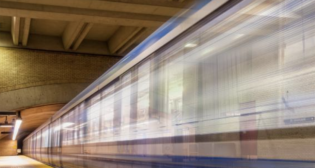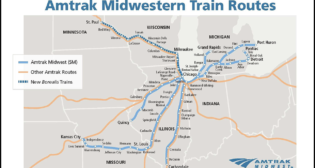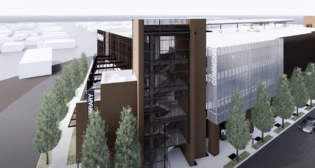
Canada goes the distance(s)
Written by John Thompson, Canadian Contributing EditorThree regional rail systems, along with VIA Rail intercity service, form Canada’s primary rail passenger network. Each faces its own physical and fiscal challenges, relying on a fluctuating mix of city, provincial, and federal funding support.
AMT manages Montreal
Montreal, Quebec, Canada’s second-largest city, enjoys the country’s only electrified regional service, along with an extensive diesel-powered train service and express buses provided by Agence Metropolitaine de Transport (AMT). AMT covers the Greater Montreal Region, embracing 63 municipalities and one First Nations reserve, 13 regional county municipalities, and 21 transit authorities.
AMT links the downtown core with communities as far west as Hudson, east to Mont-Saint-Hilaire, and Saint-Jerome to the north. Trains run to and from VIA’s Central Station, and Lucien L’Allier terminal on tracks owned by CN, CP, and the Quebec Gatineau Railway. AMT owns trackage between Saint-Therese and Saint-Jerome, and all of the Deux-Montagnes line, including the Mount Royal Tunnel. The latter is electrified, using electric multiple-unit (EMU) cars built some 20 years ago, and recently introduced Bombardier ALP-45DP dual-power locomotives and 160 Multi-Level coaches (pictured, above) ordered in conjunction with NJ Transit.
AMT serves 51 stations and 73,900 daily riders with a range of Bombardier equipment, including 58 Bombardier MR-90 single-level EMUs; the MultiLevels, built 2008-2011; 22 BiLevel coaches built in 2004; and 24 single-level coaches built in 1989. AMT has decided to standardize on the MultiLevels for future equipment acquisitions.
Future plans include improved service to Montreal’s West Island suburbs. Daily departures would be tripled, operating on two new tracks dedicated to AMT trains. Maintenance facilities are planned for Lachine and Point-Sainte-Charles, serving trains routed over CP and CN lines, respectively. A capacity increase is planned for Mount Royal Tunnel.
On the Deux-Montagnes line, an underpass beneath CN’s Saint-Laurent freight line for AMT trains is planned, estimated to cost C$60 million. Extending double-track four miles from Bois-Franc station to Roxboro-Pierrefond station would cost C$51 million. On the Candiac Line, an extension to Saint-Jean-sur-Richelieu is being discussed.
GO Transit sets the pace
Government of Ontario Transit (GO Transit) is Canada’s oldest and largest regional rail agency, and perhaps the best known outside of Canada. GO Transit was regarded as avoiding the need to widen the Queen Elizabeth Way, a limited-access highway, between Toronto and Hamilton. Originally conceived as a three-year experiment, it proved extremely popular. Expansion moved forward in the 1970s and 1980s, reaching Georgetown in 1974, Richmond Hill in 1978, Milton and Bradford in 1981, and Stouffville in 1982.
In recent years the Georgetown service has been extended westward to Kitchener, and the Bradford line northward to Barrie. Lakeshore service goes eastward to Oshawa and westward to Aldershot. seasonal weekend trains operate to Niagara Falls, Ontario. Train service is chiefly weekday peak period, although all-day, seven days per week service prevails on the Lakeshore line. Daily ridership in 2012 averaged 187,000 passengers. The Lakeshore line is by far the busiest, recording almost half of the total ridership.
GO Transit today operates 574 Bombardier BiLevel cars, with 115 more on order; eight EMD F59PH locomotives, and 67 MotivePower Industries MP40PH-3Cs, with 10 more ordered for 2016 delivery. Heavy maintenance is performed at the Willowbrook Shops, in the former western suburb of New Toronto, adjacent to the Lakeshore West line.
Toronto Union Station is undergoing a major rebuilding, which includes facilities for Union Pearson Express, the new airport rail service linking Pearson International Airport with Union Station, slated to commence in 2015. The former Toronto, Hamilton & Buffalo station in Hamilton was extensively rebuilt in the mid-1990s to serve the four weekday trains to that city, as well as GO, local, and other intercity buses. A new station is being built in Hamilton’s north downtown, on the CN Lakeshore line, to serve four additional GO trains, commencing in 2015.
West Coast Express: Small But Relevant
Located on the Pacific coast, West Coast Express (WCE) is Canada’s newest regional train service, having commenced operations November 1, 1995. It is a single-line operation, extending eastward about 43 miles from the former CP downtown terminal to Mission, over CP’s transcontinental main line.
Trains operate weekdays, excluding holidays, with five daily trains running into Vancouver during the morning peak periods, returning in the evening. A one-way trip requires 75 minutes. There are eight stations.
WCE is operated by Translink, the transportation authority of the Metro Vancouver Region. Daily ridership is approximately 11,000 passengers.
Each WCE train comprises a General Motors F59PH1 locomotive and five to 10 Bombardier BiLevel coaches, operating in push-pull mode. A single MotivePower Industries MP36PH-3C locomotive is available for backup. The fleet numbers 44 coaches.
WCE makes connections with the better-known Skytrain, Vancouver’s mostly-elevated rapid transit system.
The locomotives and coaches were originally maintained by VIA Rail. Bombardier Transportation began a five-year contract to service and operate the trains, commencing May 5, 2014.
VIA vies for relevance
Tying the three regional passenger rail systems together is VIA Rail Canada, offering a basic (some would say skeletal) coast-to-coast rail passenger system, extending from Halifax on the Atlantic coast to Vancouver on the Pacific, serving this vast but sparsely populated nation of roughly 35 million. VIA Rail operates over a 7,800-mile network as a tenant of CN and CP.
Established on April 1, 1978 as a Crown Corporation, VIA Rail initially took possession of CN and CP’s passenger cars and locomotives. Passenger services operated by other railways, such as the Ontario Northland and Algoma Central Railways, were not assumed.
Political support for VIA has run the gamut from enthusiastic to lukewarm to hostile—an easy target for federal budget slashing. But the railroad’s flagship long-distance train, the Canadian, has benefitted from a major overhaul of existing stainless steel equipment, along with conversion to head-end power, to extend equipment lifespan significantly.
VIA patronage increased from 3.8 million in 2005 to 4.1 million in 2006. In 2007, VIA received funding of C$691.9 million over a five-year period, including C$519 for capital needs. This money was used, among other projects, for rebuilding 54 F40PH-2 locomotives to meet current emission standards and prolong their lives for 15-20 years; refurbishing LRC coach interiors; reducing track capacity bottlenecks and speed restrictions on the Quebec City-Windsor Corridor by rebuilding significant sections of track; rebuilding a number of stations, including Toronto Union; and buying and rebuilding some second-hand British rolling stock.
The government appropriated a further C$407 million in 2009 for capital work. At present, eight ex-CPR Chateau-series sleepers and four Park-class observation sleepers are being rebuilt with deluxe bedrooms.
Recently, VIA announced an expenditure of C$10.2 million for rebuilding about 45 miles of CN track in northern New Brunswick used by the Ocean.
Unlike Amtrak in the U.S., VIA has lacked formal Canadian rail legislation, as the railway was created by an Order in Council. Such legislation would allow VIA to seek funding on the open market, rather than be at the whim of the government. And, there is nothing comparable to the U.S. 403 (B) legislation that would allow individual Canadian provinces to fund certain VIA services.
Many studies have been conducted over the years on high speed rail service, but the political will to implement such operations has been and remains lacking. VIA’s Corridor and Transcontinental services will likely continue in their reduced form for the mid-term, but the time of decision will come when its equipment requires replacement.



